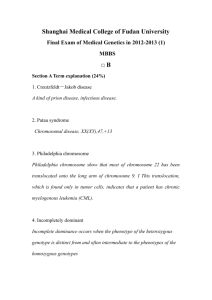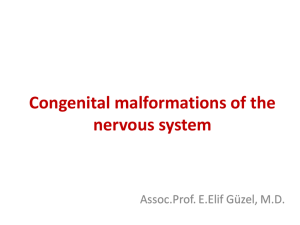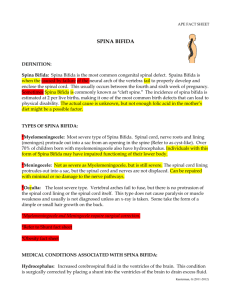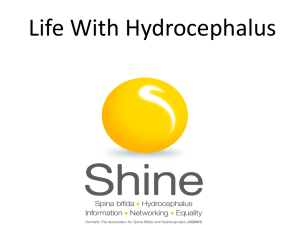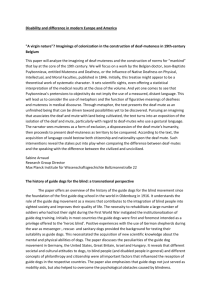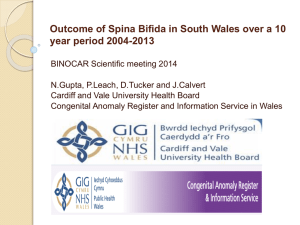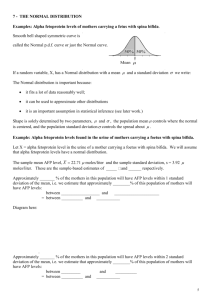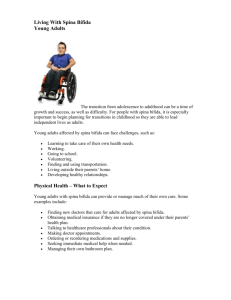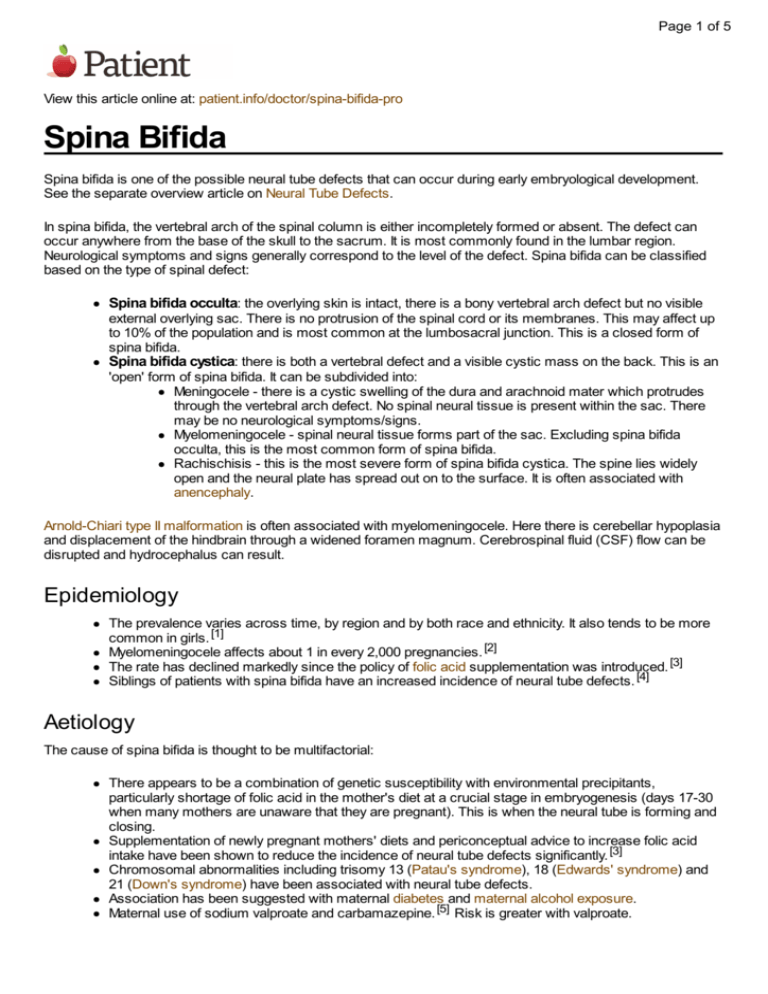
Page 1 of 5
View this article online at: patient.info/doctor/spina-bifida-pro
Spina Bifida
Spina bifida is one of the possible neural tube defects that can occur during early embryological development.
See the separate overview article on Neural Tube Defects.
In spina bifida, the vertebral arch of the spinal column is either incompletely formed or absent. The defect can
occur anywhere from the base of the skull to the sacrum. It is most commonly found in the lumbar region.
Neurological symptoms and signs generally correspond to the level of the defect. Spina bifida can be classified
based on the type of spinal defect:
Spina bifida occulta: the overlying skin is intact, there is a bony vertebral arch defect but no visible
external overlying sac. There is no protrusion of the spinal cord or its membranes. This may affect up
to 10% of the population and is most common at the lumbosacral junction. This is a closed form of
spina bifida.
Spina bifida cystica: there is both a vertebral defect and a visible cystic mass on the back. This is an
'open' form of spina bifida. It can be subdivided into:
Meningocele - there is a cystic swelling of the dura and arachnoid mater which protrudes
through the vertebral arch defect. No spinal neural tissue is present within the sac. There
may be no neurological symptoms/signs.
Myelomeningocele - spinal neural tissue forms part of the sac. Excluding spina bifida
occulta, this is the most common form of spina bifida.
Rachischisis - this is the most severe form of spina bifida cystica. The spine lies widely
open and the neural plate has spread out on to the surface. It is often associated with
anencephaly.
Arnold-Chiari type II malformation is often associated with myelomeningocele. Here there is cerebellar hypoplasia
and displacement of the hindbrain through a widened foramen magnum. Cerebrospinal fluid (CSF) flow can be
disrupted and hydrocephalus can result.
Epidemiology
The prevalence varies across time, by region and by both race and ethnicity. It also tends to be more
common in girls. [1]
Myelomeningocele affects about 1 in every 2,000 pregnancies. [2]
The rate has declined markedly since the policy of folic acid supplementation was introduced. [3]
Siblings of patients with spina bifida have an increased incidence of neural tube defects. [4]
Aetiology
The cause of spina bifida is thought to be multifactorial:
There appears to be a combination of genetic susceptibility with environmental precipitants,
particularly shortage of folic acid in the mother's diet at a crucial stage in embryogenesis (days 17-30
when many mothers are unaware that they are pregnant). This is when the neural tube is forming and
closing.
Supplementation of newly pregnant mothers' diets and periconceptual advice to increase folic acid
intake have been shown to reduce the incidence of neural tube defects significantly. [3]
Chromosomal abnormalities including trisomy 13 (Patau's syndrome), 18 (Edwards' syndrome) and
21 (Down's syndrome) have been associated with neural tube defects.
Association has been suggested with maternal diabetes and maternal alcohol exposure.
Maternal use of sodium valproate and carbamazepine. [5] Risk is greater with valproate.
Page 2 of 5
Presentation
Spina bifida cystica
The abnormal herniation of the dural sac/neural tissue is usually evident, either during antenatal
ultrasound scanning or at birth.
Classically, the disruption of spinal cord function causes sensory dysfunction, flaccid paralysis and
areflexia below the affected level. An alternative pattern includes the preservation of some distal reflex
activity which is usually exaggerated.
In cases of meningocele alone, the herniation of the meninges is often covered by skin so the lesion
may be more difficult to detect.
Imbalanced muscle forces can lead to spinal deformity, limb contractures and joint dislocations.
Arnold-Chiari II malformation may present with stridor or apnoea. Impaired cerebellar function can
affect balance, co-ordination and walking. Hydrocephalus, seizures and impaired cognitive function
may be present. [1]
Spina bifida occulta
This is common and more difficult to detect.
There are usually no neurological sequelae or long-term consequence.
There may be no cutaneous marker, or there may be an obvious abnormality along the spine including:
A fluid-filled cystic mass.
An area of hyperpigmentation or hypopigmentation.
Cutis aplasia.
Congenital dermal sinus (this may lead to meningitis or spinal abscess).
Capillary telangiectasias/haemangioma.
Hypertrichosis (a hairy patch of skin).
Skin appendages.
An asymmetrical gluteal cleft.
The risk of significant spinal malformations in asymptomatic, healthy infants with an isolated simple
sacral dimple is very low. [6]
Asymmetry of the legs/feet may be present.
Scoliosis or other spinal deformities may develop.
Progressive neurological motor and/or sensory deficits can develop with associated bladder or bowel
disturbance (because of associated tethering of the spinal cord).
There may be low back pain as the individual gets older.
A sudden onset of pain, motor and sensory loss and bladder dysfunction can occur after acute trauma
if there is spinal cord tethering.
Differential diagnosis
The classical appearance of spina bifida cystica is not likely to be confused with other pathologies.
Examination
Examine the spine and note the site and size of any lesion. Look for any spinal deformity.
Perform a complete neurological examination of the newborn. Document any neurological
abnormalities. This will act as a baseline:
Measure head circumference.
Assess cry and sucking reflex.
Assess anal sphincter.
Examine urinary stream.
Perform a full motor examination, including assessment of muscle bulk, spontaneous
active movements, muscle tone and movements in response to stimulation.
Perform a full sensory examination.
Look for foot and hip deformities.
Page 3 of 5
Investigations
Prenatal diagnosis
Raised levels of maternal serum alpha-fetoprotein (AFP) at 16-18 weeks of gestation are found in
neural tube defects.
The 18- to 20-week fetal anomaly screening ultrasound scan allows detection and diagnosis of neural
tube defects and is much more specific. [7]
When amniocentesis is done, amniotic fluid AFP and acetylcholinesterase concentrations can be
used to differentiate between open ventral wall defects (gastroschisis and omphalocele) and open
neural tube defects.
Investigation of confirmed spina bifida
Screening bloods can be carried out to detect any evidence of impairment of other organ systems,
particularly renal impairment.
Urine culture and urodynamics may be needed to detect any abnormality of the urinary tract caused by
impaired bladder innervation.
Latex allergy is relatively common among sufferers of spina bifida, probably due to inherent
susceptibility and repeated exposure to surgical procedures. [8]
Enzyme-linked immunosorbent assay (ELISA) or skin-prick sensitivity testing may be needed to avoid
illness caused by latex exposure. 40% of children with myelomeningocele may be latex-sensitive.
Plain X-rays of the spine can help to detect any associated scoliosis and hip dysplasia or dislocation.
CT and/or MRI scanning of the head and spinal cord may be conducted to look for evidence of the
major complications of spina bifida, such as:
Hydrocephalus due to Arnold-Chiari II malformation.
Tethering of the spinal cord by fibrous bands.
Gait analysis may be needed to evaluate a patient's functional mobility and allow intervention to
improve independent mobility through the use of orthoses or surgery.
Management
General measures
Nurse any newborn with an open neural tube defect in the prone position and cover the defect with a
sterile wet saline dressing.
A multidisciplinary team approach is needed in the management of an infant with spina bifida.
Treatment aims are to maximise mobility, prevent or ameliorate complications of spina bifida
(particularly hydrocephalus), encourage as normal as possible development, and to help the individual
maintain as independent a life as possible.
Repair of the defect
Fetal surgery for myelomeningocele before 26 weeks of gestation may preserve neurological function,
reverse the hindbrain herniation of the Chiari II malformation, and prevent the need for postnatal
placement of a ventriculoperitoneal shunt. [9]
Postnatal surgical treatment to correct the spinal cord malformation must be achieved during the first
days of life. [10]
Other interventions
Ongoing management of mobility, utilising orthopaedic assessment, bracing and orthopaedic surgery,
is often necessary. Spinal fusion, hip, pelvic or foot/ankle procedures are often needed. [11]
Prolonged physiotherapy, access to gym resources and/or adaptive training in children can be very
helpful in maintaining independence and mobility.
Developmental assessment by a paediatrician and help with maintaining a normal weight (weight gain
is common due to impaired ambulation and can increase morbidity) are useful.
Occupational therapy assessment and intervention can help to maximise function.
Psychological input for the individual and their family to deal with the ramifications of their condition as
they grow older is often needed.
Neurosurgical follow-up is necessary to detect and treat complications such as hydrocephalus or a
possible tethered cord.
Page 4 of 5
Bladder and bowel function can be maintained or aided by the use of a regular bowel voiding regimen
and intermittent self-catheterisation.
Complications
Meningitis (especially in open neural tube defects).
Fractures (particularly of lower-limb long bones) and hip dislocations. These may be asymptomatic.
There may be disuse osteoporosis and osteopenia.
Pressure sores because of problems with mobility.
Skin ulceration around orthoses/braces.
Hydrocephalus due to Arnold-Chiari II malformation causing developmental impairment.
Neurogenic bladder causing incontinence and urinary tract infection.
Constipation due to impaired bowel innervation and anal sphincter function.
Latex allergy leading to anaphylaxis. [8]
Prognosis
With the advent of prenatal surgery, early repair of postnatal myelomeningocele, shunting to prevent
hydrocephalus and expectant management of complications, most patients born with spina bifida survive into
adulthood and develop relatively normally intellectually.
Long-term survival depends on adherence to appropriate bowel and bladder regimens and careful
management of urinary complications to prevent chronic kidney disease.
Long-term outlook is very variable and depends on the degree of neurological deficit. [12]
Patients with hydrocephalus and a lesion at the level of L2 or above seem to be more dependent with
regards to sphincter control, locomotion, self-care, social cognition, and communication. [13]
Half of deaths (after the age of 5 years) are sudden and unexpected. Most occur in the community and
the most frequent causes are epilepsy, pulmonary embolus, acute hydrocephalus and acute renal
sepsis. [14]
Prevention
Periconceptual supplementation of folic acid and improved folate content in the diet of the general
population (possibly through food fortification). [3]
Folic acid may also help to reduce the severity of neural tube defects as well as preventing their
occurence. [15]
Improved prenatal diagnosis and prenatal surgery or termination of some pregnancies may reduce the
future burden of disability caused by this condition.
Further reading & references
1. Mitchell LE, Adzick NS, Melchionne J, et al; Spina bifida. Lancet. 2004 Nov 20-26;364(9448):1885-95.
2. Copp AJ, Stanier P, Greene ND; Neural tube defects: recent advances, unsolved questions, and controversies. Lancet
Neurol. 2013 Aug;12(8):799-810. doi: 10.1016/S1474-4422(13)70110-8. Epub 2013 Jun 19.
3. De-Regil LM, Fernandez-Gaxiola AC, Dowswell T, et al; Effects and safety of periconceptional folate supplementation for
preventing birth defects. Cochrane Database Syst Rev. 2010 Oct 6;(10):CD007950. doi:
10.1002/14651858.CD007950.pub2.
4. Neural tube defects; Online Mendelian Inheritance in Man (OMIM)
5. Jentink J, Dolk H, Loane MA, et al; Intrauterine exposure to carbamazepine and specific congenital malformations: BMJ.
2010 Dec 2;341:c6581. doi: 10.1136/bmj.c6581.
6. Kucera JN, Coley I, O'Hara S, et al; The simple sacral dimple: diagnostic yield of ultrasound in neonates. Pediatr Radiol.
2014 Jul 5.
7. Cameron M, Moran P; Prenatal screening and diagnosis of neural tube defects. Prenat Diagn. 2009 Apr;29(4):402-11.
8. Ausili E, Tabacco F, Focarelli B, et al; Prevalence of latex allergy in spina bifida: genetic and environmental risk Eur Rev
Med Pharmacol Sci. 2007 May-Jun;11(3):149-53.
9. Adzick NS; Fetal surgery for spina bifida: past, present, future. Semin Pediatr Surg. 2013 Feb;22(1):10-7. doi:
10.1053/j.sempedsurg.2012.10.003.
10. Zerah M, Kulkarni AV; Spinal cord malformations. Handb Clin Neurol. 2013;112:975-91. doi: 10.1016/B978-0-444-529107.00018-0.
11. Swaroop VT, Dias L; Orthopedic management of spina bifida. Part I: hip, knee, and rotational J Child Orthop. 2009 Oct 25.
12. Oakeshott P, Hunt GM, Poulton A, et al; Open spina bifida: birth findings predict long-term outcome. Arch Dis Child. 2012
May;97(5):474-6. doi: 10.1136/archdischild-2011-300624. Epub 2011 Nov 25.
Page 5 of 5
13. Verhoef M, Barf HA, Post MW, et al ; Functional independence among young adults with spina bifida, in relation to
hydrocephalus and level of lesion. Dev Med Child Neurol. 2006 Feb;48(2):114-9.
14. Oakeshott P, Hunt GM, Poulton A, et al; Expectation of life and unexpected death in open spina bifida: a 40-year Dev Med
Child Neurol. 2010 Aug;52(8):749-53. Epub 2009 Dec 9.
15. Bol KA, Collins JS, Kirby RS; Survival of infants with neural tube defects in the presence of folic acid fortification. Pediatrics.
2006 Mar;117(3):803-13.
Disclaimer: This article is for information only and should not be used for the diagnosis or treatment of medical
conditions. EMIS has used all reasonable care in compiling the information but make no warranty as to its
accuracy. Consult a doctor or other health care professional for diagnosis and treatment of medical conditions.
For details see our conditions.
Original Author:
Dr Sean Kavanagh
Current Version:
Dr Colin Tidy
Peer Reviewer:
Dr Hayley Willacy
Document ID:
2795 (v24)
Last Checked:
24/07/2014
Next Review:
23/07/2019
View this article online at: patient.info/doctor/spina-bifida-pro
Discuss Spina Bifida and find more trusted resources at Patient.
© EMIS Group plc - all rights reserved.

